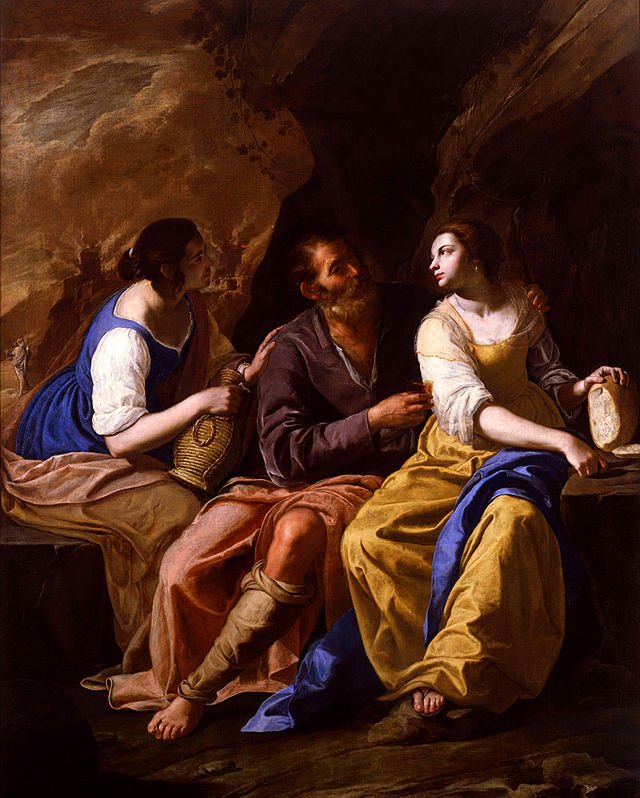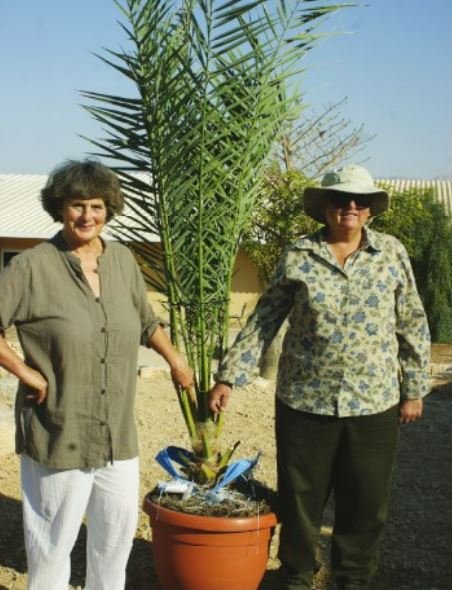Today’s page of Talmud focuses on the acts of incest committed by Lot and his two daughters:
נזיר כג, א
אמר רבה בר בר חנה אמר רבי יוחנן מאי דכתיב כי ישרים דרכי ה' וצדיקים ילכו בם ופושעים יכשלו בם... משל ללוט ושתי בנותיו עמו הן שנתכוונו לשם מצוה וצדיקים ילכו בם הוא שנתכוין לשם עבירה ופושעים יכשלו בם
ודלמא הוא נמי לשום מצוה איכווין? אמר רבי יוחנן כל הפסוק הזה על שם עבירה נאמר וישא לוט ותשא אשת אדוניו את עיניה [את עיניו] כי היא ישרה בעיני וירא וירא אותה שכם בן חמור את כל ככר הירדן כי בעד אשה זונה עד ככר לחם כי כלה משקה אלכה אחרי מאהבי נותני לחמי ומימי צמרי ופשתי שמני ושיקויי והא מינס אניס תנא משום רבי יוסי בר רב חוני למה נקוד על וי"ו ובקומה של בכירה לומר שבשכבה לא ידע אבל בקומה ידע ומאי הוה ליה למיעבד מאי דהוה הוה נפקא מינה דלפניא אחרינא לא איבעי למישתי חמרא
Rabbah b. Bar Hana, quoting R. Johanan, said: The verse, "For the ways of the Lord are right, and the righteous shall walk in them,' but transgressors do stumble therein," may be illustrated by the following example...of Lot and his two daughters. To these [the daughters], whose intention it was to do right, [applies], 'the righteous shall walk in them', whereas to him [Lot] whose intention it was to commit the transgression [applies], 'but transgressors do stumble therein'.
But perhaps [Lot too had] intention also to do right? — Rabbi Yochanan said [this is not the case]: The entire following verse indicates [Lot's] lustful character....But [Lot] was the victim of compulsion [because the Torah states that he was drunk]?...it was her lying down that he did not notice [in the evening, when he was drunk] but he did notice when she arose [the next morning]. But what could he have done, since it was all over? — The difference is that he should not have drunk wine the next evening [when he had sexual relations with his second daughter]....
Artemisia Gentileschi. Lot and His Daughters, 1636-1638, Toledo Museum of Art.
It's difficult to write about incest, but the Talmud detailed a discussion about father-daughter incest as an example of the importance of motivation. In this case, the Talmud suggests that Lot's nameless daughters were not to blame for seducing their father, since having witnessed the destruction of Sodom, they believed that the three of them were the last surviving members of humantiy. Lot, on the other hand is given no such pass, and Rabbi Yochanan creatively expounds a series of verses to prove that Lot was immoral to the core. Hence, Lot's drunken incest could not have been for any noble reason. He was, simply put, and evil person.
Understanding Incest Taboos
Incest taboos are not unique to western society or the Judeo-Chrsitian tradition. They have been identified in at least 250 societies across the world, "including fifth century Iran, the Inca and Mixtec empires, Korea during the Koryo period, pre-conquest Hawaii, the Calusa chiefdom in South Florida, Ponape in the South Pacific, lele and Bushanga in equitorial Africa, and, most famously, Ptolemaic Egypt." But why these taboos are so widespread - and felt so strongly - is a puzzling question.
Some have suggested that the taboo exists because incestuous unions produce genetically inferior offspring. "The taboo was a kind of public health measure" wrote Arthur Wolf in his work Incest Avoidance and the Incest Taboos "enacted for the sake of the minority of people who failed to recognize the danger or lacked the will to take precautionary measures." This explanation is called the hygiene hypothesis, but there are others. Sigmund Freud (in Totem and Taboo) suggested it was all about group harmony, while others claimed it was all about group alliances: if you can't procreate with your father or brothers, you must look to another family unit - or remain celibate.
“If erotic passion were allowed to invade the precincts of the home it would not merely establish jealousies and competitive elements and disorganize the family but it would subvert the most fundamental bonds of kinship on which the further development of all social relations is based...A society which allowed incest could not develop a stable family; it would therefore be deprived of the strongest foundations of kinship, and this in a primitive community would mean absence of social order.”
The Westermarck Hypothesis and the Kibbutzim
In 1891 the Finnish sociologist Edward Westermark hypothesized that the key to understanding incest taboos was to look at how the young were raised. Kin raised apart might in fact be interested in each other if they met as adults, while non-kin raised togther would not form sexual bonds, despite being free to do so. Westermarck's hypothesis soon fell out of favor, but was later re-evaluated on the basis of some natural experiments, one of which occurred on Israeli kibbutzim of the 1930s and 1940s. In many (or perhaps most?) of these kibbutzim, children were not raised with their parents, but in communal nurseries and houses, where they would live until they graduated from high school. Despite there being no incest based prohibition among the children, the Israeli sociologist Yonina Talmon found that they rarely married each other. Talmon's 1964 paper was followed by a much larger study of over 2,700 marriages; in only thirteen cases had the husband and wife belonged to the same peer group. But there was not a single case of marriage between children who had been brought together before the age of three and reared together.
Incestuous Origins
The Talmud (Nazir 23b) continues the discussion of Lot's incest and contrasts it with the incestuous act of Tamar, who seduced her father-in-law Yehudah:
Tamar engaged in immoral relations [with her father-in-law Yehudah, but because her intentions were noble] kings and prophets descended from her...
Among the descendants of Tamar and Yehudah were King David, and the prophet Isaiah (see Tosafot to Nazir 23b). Arthur Wolf points out that many societies have a legend of incestuous ancestors, and asks why they would trace their descent to an abnormal event predicting evil? There are a number of possibilities, but here's one that seems especially plausible:
...myth-makers attribute incest to the ancestors they create to emphasize that they are not ordinary human beings. that they are a special kind of being, more like gods than men. The source of mythical incest would then be the awe inspired by incest rather than a desire to commit incest. (Wolf. Incest Avoidance and the Incest Taboos. Stanford University Press 2014. 116.)
Father-Daughter Incest in American History
The story of Lot and his daughters, told in Bereshit 19:29-38, is not as horribly remote a possibility as we could like to believe. In her 2009 book Unspeakable: Father-Daughter Incest in American History, Lynn Sacco notes that Marilyn Atler, who was crowned Miss America 1958, was abused by her father for thirteen years. Sacco found more than “five hundred reports of father-daughter incest, published in more than nine hundred newspaper articles across the country, mostly between 1817 and 1899.” And then something weird happened. The number of newspaper reports of father-daughter incest dropped off – there were fewer than 140 between 1900 and 1940. Sacco has a fascinating explanation for this: she claims that at the turn of the nineteenth century doctors were able to diagnose (though not yet treat) sexually transmitted diseases with much greater accuracy than ever before. With this came the realization that gonorrhea was “epidemic among girls, including the daughters of the white middle and upper classes.”
“Doctors were not naïve to the fact that men sexually assaulted girls, including their own daughters. But doctors and reformers could not believe that incest occurred frequently enough among white middle- and upper-class Americans to account for the incidence of infection”
But how could so many of these young girl, some as young as five, have become infected? Rather than consider the possibility of a father as the source, “doctors swiftly revised their views about the etiology of gonorrhea, not their assumptions about the sexual behavior of white Americans.” In so doing, they claimed that girls –and girls alone, were susceptible to infection with gonorrhea from “everyday nonsexual objects, including their mothers’ hands, bed linens, other girls, and toilet seats.”
These theories found their way into the non-medical community. For example, the Chicago Society of Social Hygiene issued a pamphlet in 1907 titled For the Protection of Wives and Children from Venereal Disease. It warned about the dangers of disease in girls, but did not suggest that men infected their daughters. Other reformers emphasized the role of “seats of water closets, bath tubs, towels and sponges…” and some blamed class. A Committee of the American Pediatric Society stated that “true gonorrhea affected only indigent and low income patients”and the great lawyer Clarence Darrow wrote in his work Crime; Its Cause and Treatment that that incest “is peculiarly a crime of the weak, the wretched and the poor.” In truth, incest knows no such class boundaries, and the refusal of the medical establishment early last century to face the true scope of father-daughter incest caused tremendous damage to the victims. The story of Lot and his daughters is unusual - the daughters, do after all, initiate the incest - but at its essence, it is the story of alcohol, eschatology, and family dysfunction. And those factors are with us to this day.







